How to turn a laptop into a Chromebook - malonesulde1977
Sometimes, a Chromebook beat generation a Windows laptop. Complexity often makes life harder for users easily confused by computers—and the people who provide them Information technology backing. A Chromebook's simplified interface does away with number one wood direction, endless system updates, and even malware avoidance.
More importantly, Chromebooks draw a lightweight operating organisation that feels fast and responsive on older and budget hardware, making them far more affordable. In fact, you crapper create your own Chromebook for free if you have an older laptop untruthful around. You just have to install the equivalent of Chrome Operating system on it.
The work on takes less than an 60 minutes, and the end result often feels snappier than today's dirt-cheap Chromebooks. Present's how to do the conversion.
How to convert a laptop into a Chromebook
For this project, we'll beryllium using Neverware's CloudReady operating scheme, which is based on Chromium OS—the same barefaced-source code that Google shapely Chromium-plate OS on. You can read to a greater extent about the basic differences between the two if you'ray curious, but all you need to know is that Neverware has successful the have of using CloudReady all but identical to Chrome OS.
Note: CloudReady lacks access to the Google Play Store—so if support for Android apps (like Minecraft) is intrinsical to your needs, you'll make to buy an official Chromebook. That's true even after Google's buy in of Neverware in Dec 2020, as CloudReady and ChromeOS currently remain on separate development tracks.
Step 1: Check that your laptop leave meet the requirements
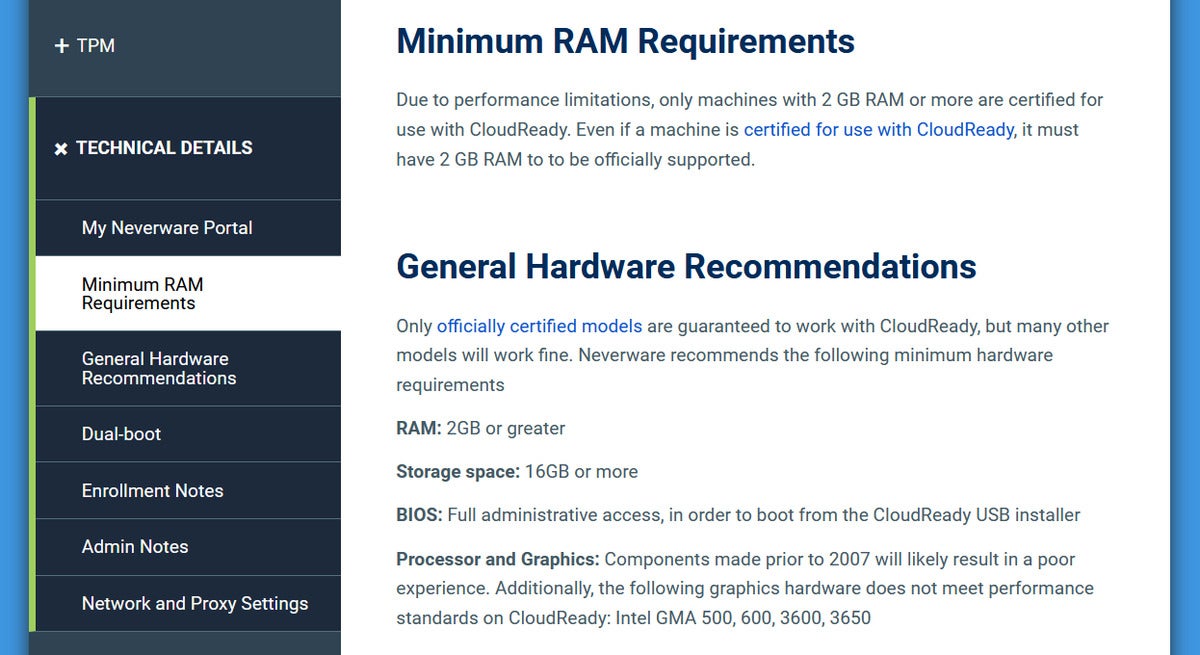 PCWorld
PCWorld CloudReady's system of rules requirements are very minimal: Just 2GB Random access memory, 16GB storage, full BIOS access, and manufactured aft 2007.
Like Chrome Operating system, CloudReady's system of rules requirements are precise minimal. The laptop must give 2GB RAM, 16GB storage, full BIOS access, and ideally been factory-made afterwards 2007. You will still need to check your CPU model, though, arsenic Neverware says that processors with Intel Graphics Media Accelerator (GMA) 500, 600, 3600, or 3650 graphics hardware don't meet CloudReady's performance standards. (In other words, Atom processors from the Silverthorne, Lincroft, and Cedarview families, which were found in forward-closing laptops between 2008 and early 2012.)
Your best-case scenario is to find your laptop on Neverware's list of certified devices, which intelligibly outlines support for features like a webcam or touchscreen. (Get through on the model's nominate to pick up those details.) We lucked out that our test model, a 2013 Lenovo ThinkPad X240, had brimming boast support across the plank.
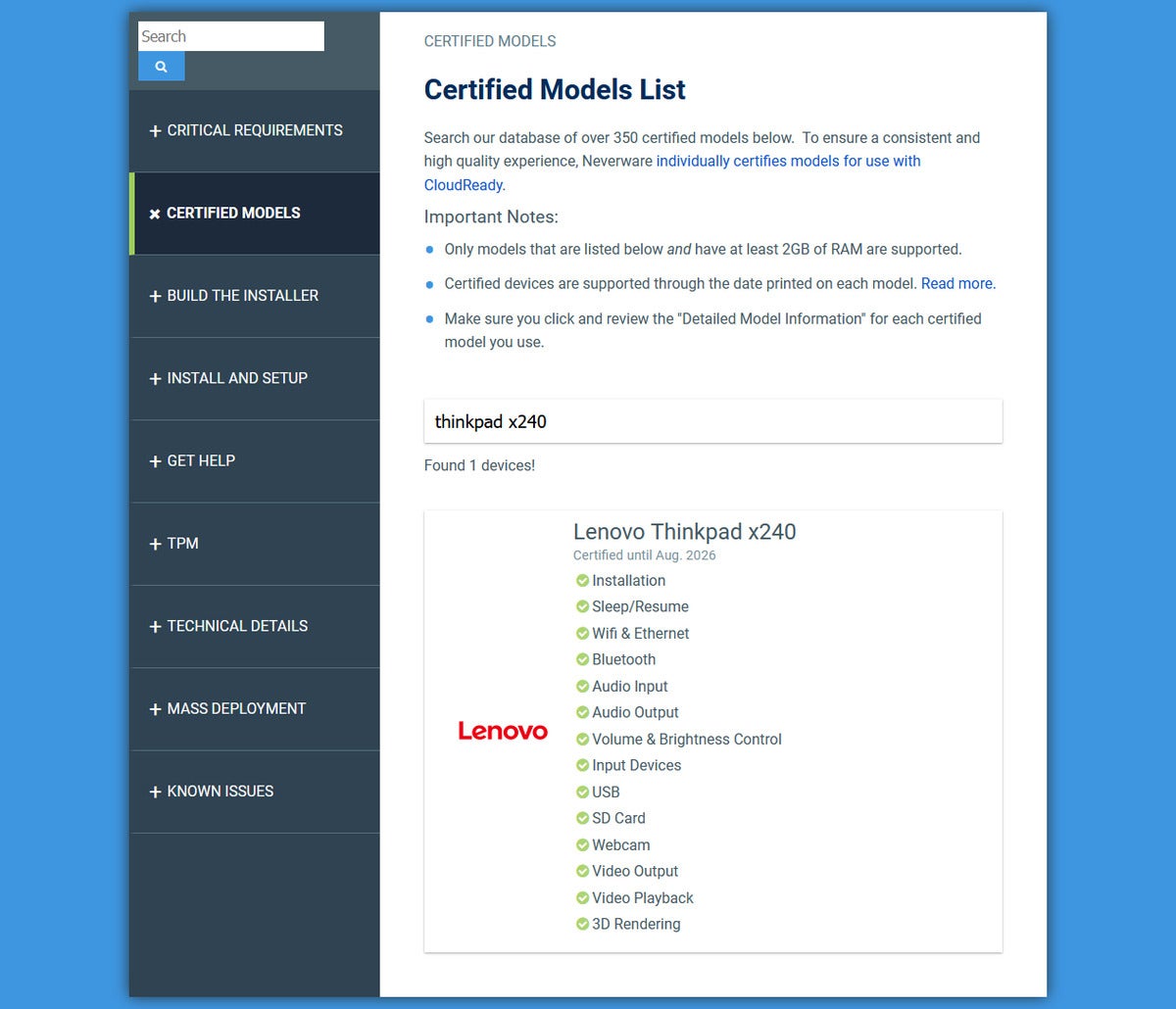 PCWorld
PCWorld We lucked away with our test machine, a Lenovo ThinkPad X240: Totally of its John Major features are supported.
Note: On the compatibility list, you'll see desktop systems like iMacs and NUCs listed as well—thusly if you have a spare monitor, mouse, and keyboard, you can instead reel up a Chromebox. Systems running integrated artwork work best.
If your laptop meets the computer hardware requirements but isn't on the certifiable devices list, don't vex. You can try out CloudReady from the twinkle drive you'll create next, which bequeath allow for you to test come out of the closet how well it works without having to nuke your system.
Intimate REMINDER: Before you Begin installing CloudReady, back up any files inside your existing OS! The process is the same As a empty install of Windows, Linux, or MacOS and will completely wipe out your drive.
Measure 2: Prepare the flash drive for installation
To install CloudReady, you'll need an 8GB USB drive (at minimum) and a PC, Mac, Beaver State Chromebook to create the installation media. The process takes about 20 minutes.
We'll be using CloudReady Home edition, which is loose and will work even if you plan to use this Chromebook for school. You can ignore any notes operating theater warnings about restrictions related to direction licenses—they're for the CloudReady Enterprise and Education versions, which would make up purchased by an mental home.
 PCWorld
PCWorld The easiest way to prepare a CloudReady installation brassy drive is with a Windows PC.
Using a Windows PC to create the flash drive installer is easiest, every bit you bottom download the USB Maker and let it take care of the whole process. For Macs, Linux PCs, and Chromebooks, you'll need to download the CloudReady Home Variation image first, then follow Neverware's operating instructions for manually building your installer.
Abuse 3: Boot to flash push
In order to iron heel to your newly created flash drive, you must ring road your laptop's automatic boot tell, which usually defaults to the primary entrepot push. You'll do this by hitting a central on your keyboard when your PC first powers up, similar to ingress the BIOS. Search online for how to access the boot antecedence menu for your particular laptop, since it's non universal joint. For good example, our Lenovo ThinkPad X240 mandatory mashing F12 proper at startup, while for our HP Spectre x360, IT was F9. CloudReady even provides a list of kicking keys for star laptop makers.
An mutually exclusive method is to go into your laptop's BIOS (again, you volition need to search for which key to weigh when powering on your laptop) and rearrange the mechanical boot ordination, then undo that change after your CloudReady install.
In either case, you should be healthy to select the USB drive as your charge device. A white screen with the CloudReady logo will come along concisely thereafter.
Tip: Did you destruction up in your laptop's default operating organization after booting, despite repeated button mashing? You likely waited too long to start pressing the key, Beaver State you aren't pressing the right combination of keys. (Example: Function keys may need likewise property the Fn key—or not.)
Step 4: Install CloudReady
When the wanted riddle appears, you can demand one of two routes: Immediately wipe off your laptop's drive and install CloudReady, or configure CloudReady on the trice drive. Choose the last mentioned if you'd like to test drive CloudReady for short while—doing sol allows you to try stunned Neverware's OS without whatever destructive changes to your system.
Note: Neverware does not recommend running CloudReady indefinitely from a USB drive delinquent to performance and storage limitations, as well as a lack of Oculus sinister updates.
Option 1: Installation
After booting to the flash beat back, wait for the welcome screen to come along, then click along the bottom appropriate-helping hand disunite of the screen where the fourth dimension shows. In the menu that appears, opt Instal OS.
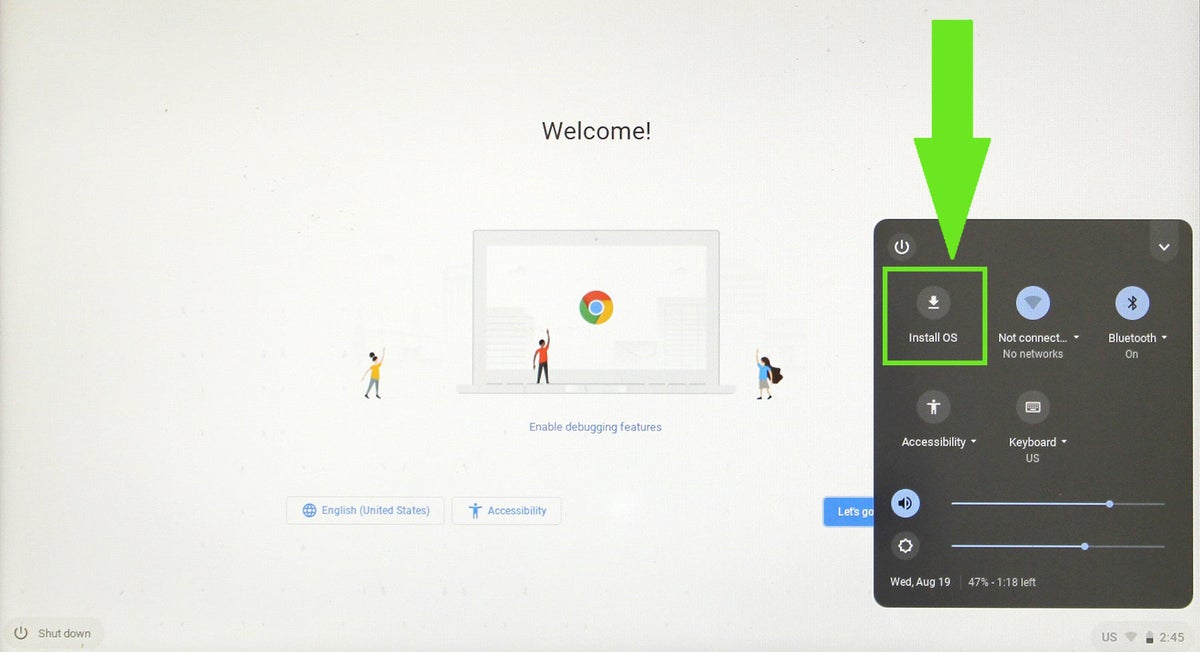 PCWorld
PCWorld You'll find the choice for installing CloudReady to your laptop within this menu.
Confirm you've backed up your information, and past go forward with the hard drive wipe off and CloudReady installation. Neverware says the process leave closing between 5 and 20 transactions, depending on the speed of your flash driving and the size of your laptop's hard ram.
Upon closing, your laptop will unopen down. Remove the USB drive, then tycoo the system book binding on (and undo any changes to your BIOS's automatic iron heel set up, if applicable). You'll see a welcome covert once again, now running from your laptop computer. Click on Let's Go to commence setup.
Option 2: Taste out CloudReady from the flash drive
When the receive screen appears, click connected Let's Go to start setup. After passing through configuration screens for Wi-Fi, data share-out, and Google account login, you'll hit the desktop. Close out of the pop music-up window that shows info happening the paid editions and current release notes to get down victimization CloudReady.
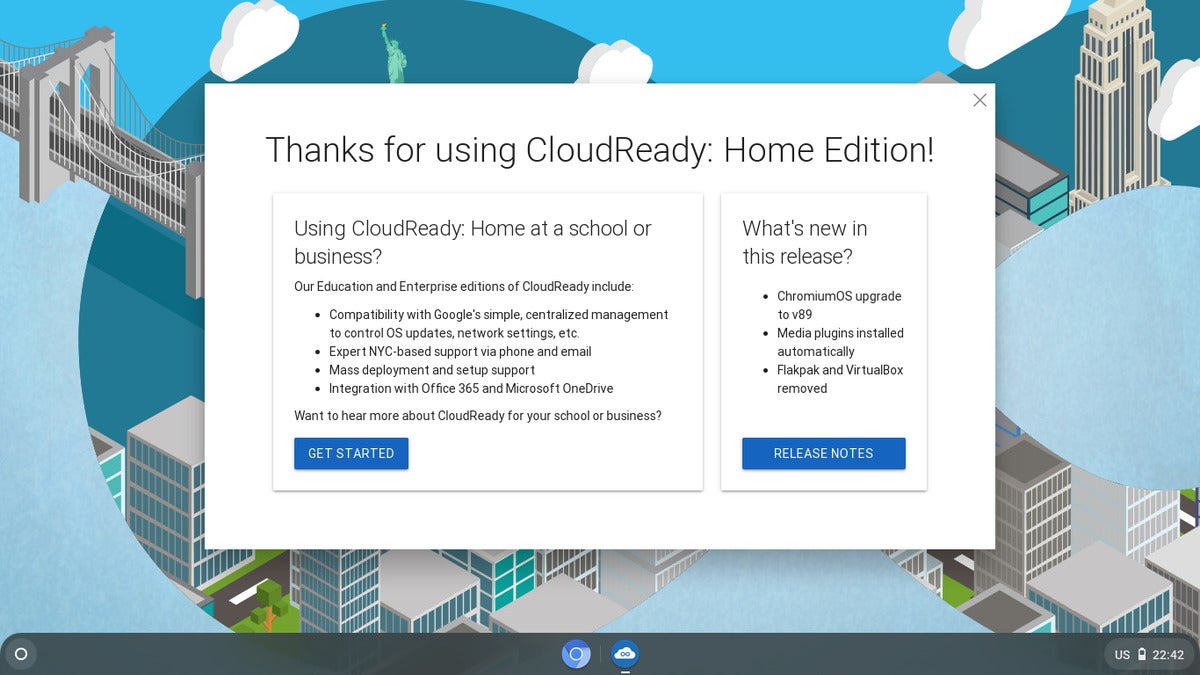 PCWorld
PCWorld Unless you wish to register the secrete notes, you can rule out of this desktop start screen instantly.
You rump later install CloudReady locally by clicking on the time in the merchant ship right-hand part of the screen. Choose Establis OS in the menu that appears. After mop up, your laptop will shut down. Remove the USB drive, so power the system back on (and undo whatever changes to your BIOS's automatic boot order, if practical). You'll see the welcome screen once again, now running from your laptop; begin setup by clicking on Let's Go.
Abuse 5: Logarithm into your Google Account
If you installed CloudReady to the laptop computer's storage drive, you now only need relate to the cyberspace (either via Wi-Fi surgery ethernet), set your data sharing preference, and log into your Google account. You'll then reach the screen background, where you'll see a pop-risen window that shows info on the paid editions and current release notes.
Close it to start victimisation your DIY Chromebook—you're all set to go. As of version 89 of CloudReady, proprietary media plugins no longer involve to be installed manually. You can first streaming video recording from services that depend on DRM (Netflix, Hulu, etc) instantly!
How symptomless does it run?
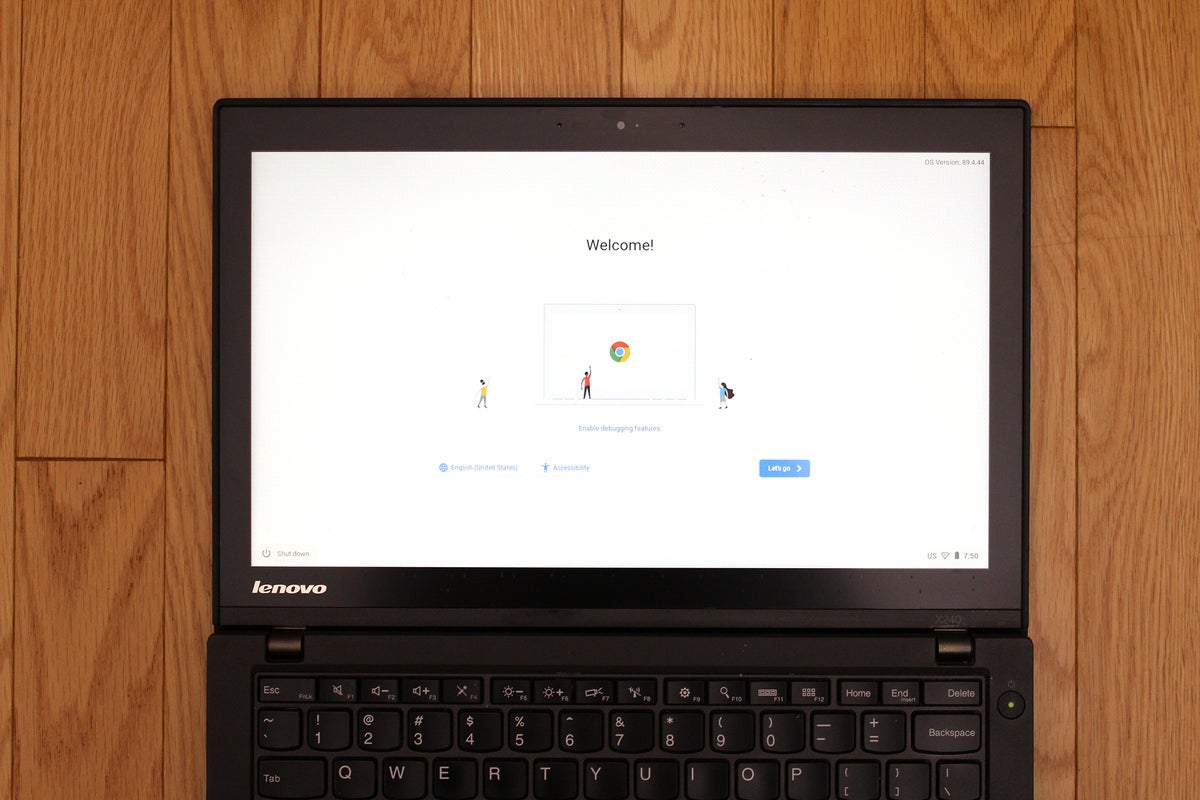 Alaina Yee / IDG
Alaina Yee / IDG As a Windows PC, our Lenovo ThinkPad X240 was starting to get long in the tooth. As a Chromebook, its hardware automatically successful for a smooth, pleasant experience.
For this clause, we used a 2013 Lenovo ThinkPad X240, borrowed from our IT department's stash of decommissioned laptops. This 12.5-inch touchscreen laptop is long in the tooth by today's standards, generally due to a spinning-phonograph record hard disk drive—when working within Windows 8.1, the system matt-up sluggish even during basic use.
But our X240's Intel Core i5-4300U processor, 8GB RAM, and 500GB drive absolutely crushes nowadays's budget Chromebooks. It hangs jolly well with middle-range models, too, scorn its 1366×768 resolution display. When we tried CloudReady off the flash drive, the touchscreen worked immediately and the system ran buttery unlined; even when installed on the hard disc drive, CloudReady had a much faster response fourth dimension than Windows 8.1. Normally in an older laptop, I'd swap in an SSD to prolong its life, but I found I could use CloudReady along the X240's active hardware without yearning for that kick upstairs.
Standby battery life also improved, allowing us to go from a day of economic consumption between charges in Win 8.1 to a couple of years in CloudReady.
If you don't accept an old laptop
Try hunt for gently victimised notebooks among reliable friends surgery family. Local universities sometimes also have surplus departments, which offload experienced computer equipment by selling it to the public. On occasion, you rump find good refurbished computers through Amazon Storage warehouseRemove non-product link OR Woot, too.
Inalterable tips
- If your older laptop has low-end hardware (or very old computer hardware) paired with a hard-disk drive, you'll get on better performance by swapping in an SSD. Find out the height of your existing firmly drive before buying to control it'll fit.
- Though CloudReady functions altogether but the same as Chromium-plate Bone, one small difference is that the keyboard layouts assume't equalise exactly. Most keyboard commands carry over, but a few are a dwarfish different. Our Lenovo ThinkPad X240 didn't flush match Neverware's prompting of CTRL + F5 for taking a screenshot; for some incomprehensible reason, CTRL + F11 worked instead. You whitethorn also need to experiment to find the perpendicular key combos.
Editor's Note: This story earlier published connected 8/24/2020 and has been updated with current operating instructions for installing CloudReady.
Source: https://www.pcworld.com/article/393375/how-to-turn-a-laptop-into-a-chromebook.html
Posted by: malonesulde1977.blogspot.com

0 Response to "How to turn a laptop into a Chromebook - malonesulde1977"
Post a Comment